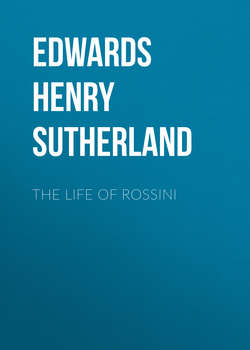Читать книгу The Life of Rossini - Edwards Henry Sutherland - Страница 4
PART I
ROSSINI AND HIS EARLY WORKS
CHAPTER III
FOUR HISTORICAL OPERAS
ОглавлениеIN bringing forward Monteverde, Scarlatti, Durante, Logroscino, and Pergolese, Jomelli, Piccinni, Paisiello, and Cimarosa, as the founders of opera, one seems to be tracing operatic history merely through names. To opera goers, who do not limit the sphere of their observation to London, it would be simpler to cite four examples of works belonging to the century before Rossini, which, if not living in the full sense of the word, are, at least, capable of revival, and have been presented to the public in their revived state during the last few years.
Pergolese’s “Serva Padrona,” an opera or operetta of the year 1731, was reproduced at Paris in 1862, for the début of Madame Galli-Marié. In this little work, which passed for its composer’s masterpiece, the accompaniments are all for stringed instruments, and as there are only two speaking characters in the drama, it naturally follows that all the musical pieces are of the simplest form. But when “La Serva Padrona” was produced, a composer, however many characters he might have to deal with, was not expected to go in the way of concerted pieces beyond a duet; and it was not until twenty years afterwards that Logroscino ventured upon a trio, and upon the first very simple model of the dramatic finale.
In Gluck’s “Orfeo” we have a well-known specimen of an opera, somewhat later in date, and much more advanced in regard to dramatic form, than the one just named. It must be remembered that “Orfeo” was originally produced in 1764, not in France, but in Italy. In Gluck’s operas we find an abundance of recitative; airs; choruses taking part in the dramatic action; occasionally duets; very rarely concerted pieces, and never finales. Gluck, like his rival Piccinni, but certainly not more than Piccinni, extended the limits of operatic art. If, as is generally admitted, he excelled in his dramatic treatment of chorus and orchestra, he neglected concerted pieces, and was not equal to the handling of those grand dramatic finales which Piccinni was the first to produce, in anything like their modern form, which Paisiello naturalised in serious opera, and which were brought to perfection in both styles by the comprehensive genius of Mozart.
A third opera by a præ-Mozartian composer, which, as it is still occasionally represented, may be cited for the further progress it exhibits in the development of operatic forms, is Cimarosa’s “Matrimonio Segretto.” Before writing this, one of his latest works (1792), its composer had been already completely distanced by Mozart, who adopted all that was worth adopting in the methods of all his contemporaries and predecessors; but to Cimarosa all the same belongs the merit of having introduced quartets and other concerted pieces, not as ornaments at the end of an act, but as integral parts of the musical drama. This important innovation occurs for the first time in Cimarosa’s “Il fanatico per le antichi Romani,” composed in 1773, thirteen years before the production of the “Marriage of Figaro.”
Cimarosa’s “Matrimonio Segretto” is also remarkable in an historical point of view for its overture, the finest that the Italian school had up to that time produced. Paisiello’s overture to the “Frascatana” had previously made a decided mark; but Rossini was the first composer of his nation who wrote a whole series of operatic overtures – “Tancredi,” “Barber of Seville,” “Gazza Ladra,” “Semiramide,” “Siege of Corinth,” “William Tell” – which became celebrated apart from the works to which they are prefixed.
The only opera of Paisiello’s which has been presented in recent times, is his original musical setting of the “Barber of Seville,” written in 1780 for the Court Theatre at St. Petersburgh. This interesting work, which was revived a couple of years ago, and is still occasionally played at one of the half dozen musical theatres in Paris called Les Fantaisies Parisiennes, is anterior to Mozart, more even in character than by date. Produced twenty years before “Il Matrimonio Segretto,” and only six years before the “Marriage of Figaro,” it seems very much further removed from Mozart’s than from Cimarosa’s work. Mozart went so far beyond his contemporaries that he may almost be described as a great anticipator. Like Shakspeare he is much more modern than his immediate successors.
However Paisiello’s “Barbiere” may sometimes be heard, and is therefore better worth speaking of than works of equal or greater importance, which can only be looked at on paper; and it is interesting as marking a stage in the history of opera by the number and merit of its concerted pieces.
The opera, then, was at first nothing but recitative, or recitative and chorus; the chorus having no dramatic character, but confining itself, in imitation of the most ancient models, to solemn criticism and comment. To relieve the drawling recitative or chant, an occasional air was introduced; then more airs; then airs and duets. We have to wait until the middle of the eighteenth century for a simple trio. Then trios, quartets, finales, fully developed finales, occur. In the meantime Gluck had given great prominence to the chorus, and had cultivated choral writing with the happiest dramatic effect; and while operatic forms, especially in regard to the employment of the voices, had been gradually varied and extended by the Italians, the instrumental writers of Germany, more especially Haydn, had invented new orchestral combinations. Mozart appeared; and appropriating all in music that had gone before – joining to all the vocal forms of the Italians all the instrumental forms of the Germans, while improving, developing, and perfecting both – helped dramatic music on to that point at which even now, speaking broadly, it may be said to remain.
